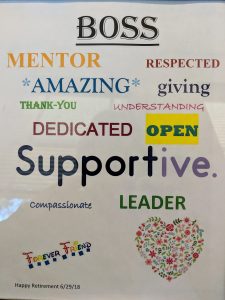One of the most amazing clients I’ve had the privilege and joy of collaborating with for 25 years recently retired. I wish there were more managers like her because it would mean more engaged and productive workplaces. Let me tell you why.
Peg helped grow a successful university distance education department, having started at a time when distance education was in its infancy. She navigated the changing technology that transitioned from broadcasting live classes via satellite to online delivery of courses. [Because she isn’t comfortable with attention, I only use her first name in this post.]
To inspire others, here’s a sample of what made Peg an impressive manager.
Management approach
All jobs come with some degree of stress from conflicting goals, operational and budget issues, internal politics, etc. Acknowledging this, Peg approached her work as an ongoing challenge: “I simply focus on what needs to be done and how to make it happen. Not just to push ahead, but with concern for how it will affect customers, employees, and everyone involved.”
I saw this play out in everyday situations and in crisis. The latter was a case of “lost in space” when a satellite failed a few days before the start of a semester. Peg rallied her team to find workable options for students and client companies with minimal service disruption.
Customer-focus was another part of Peg’s success. Besides responsive customer service, she believed in client outreach and appreciation as key to building long-term relationships with students and their employers. “Our programs may be by distance, but not our relationships,” Peg was fond of saying.
Internal marketing
Peg also focused on building relationships with employees and internal partners by:
- investing in team members by encouraging their professional development
- engaging employees in staff retreats for strategic planning, transition planning, and marketing planning
- communicating and collaborating with faculty and staff to maximize program development
- keeping employees, faculty, and administrators informed and “in the loop”
- being accessible to and respectful of those she worked with.
Her sense of humor allowed staff to comfortably let off steam in a busy, sometimes stressful environment — another key attribute to creating an effective team and supportive office culture with minimal turnover.
I know my wish for more managers like Peg is not realistic, but I can wish for people to learn from her success.







